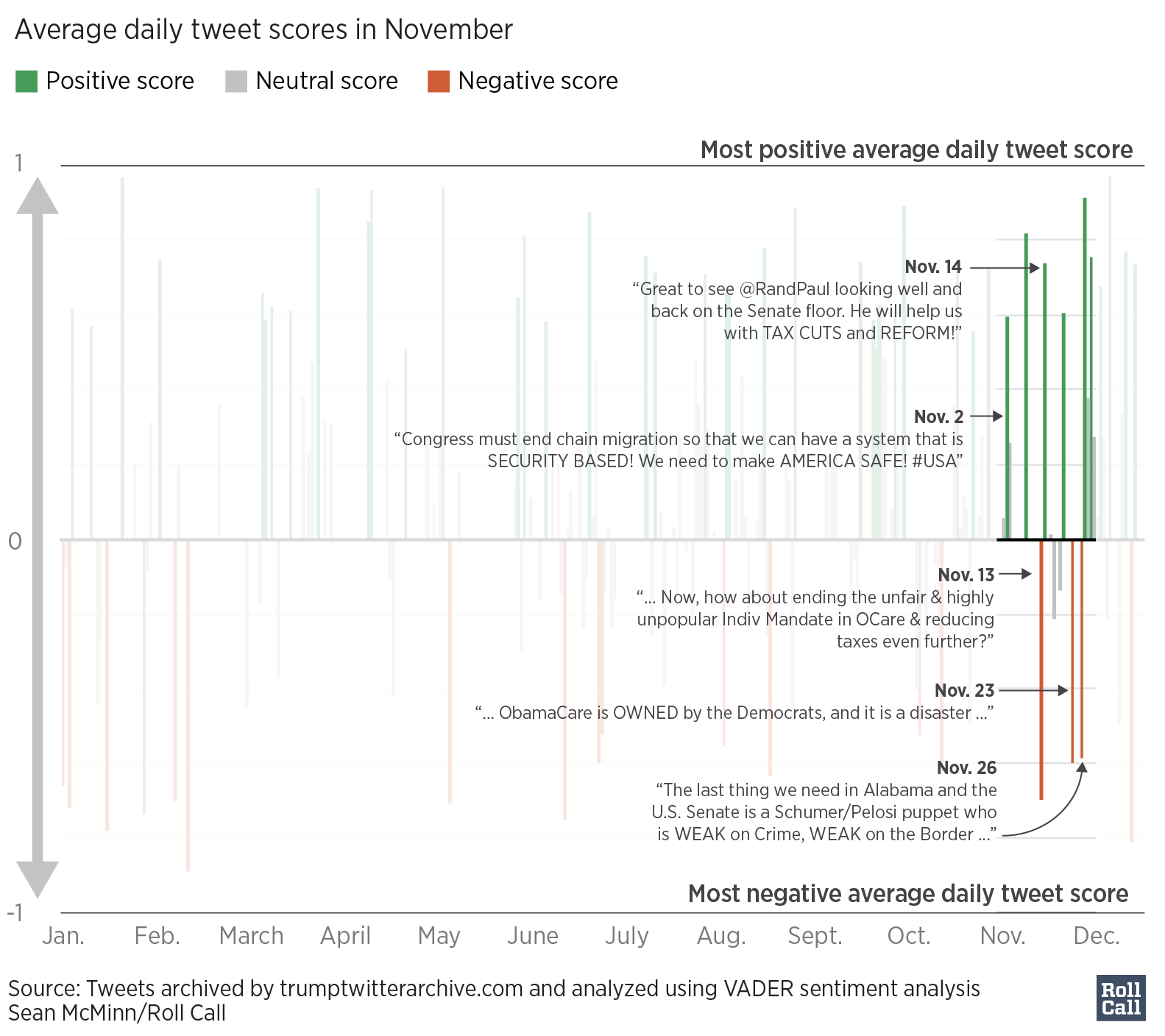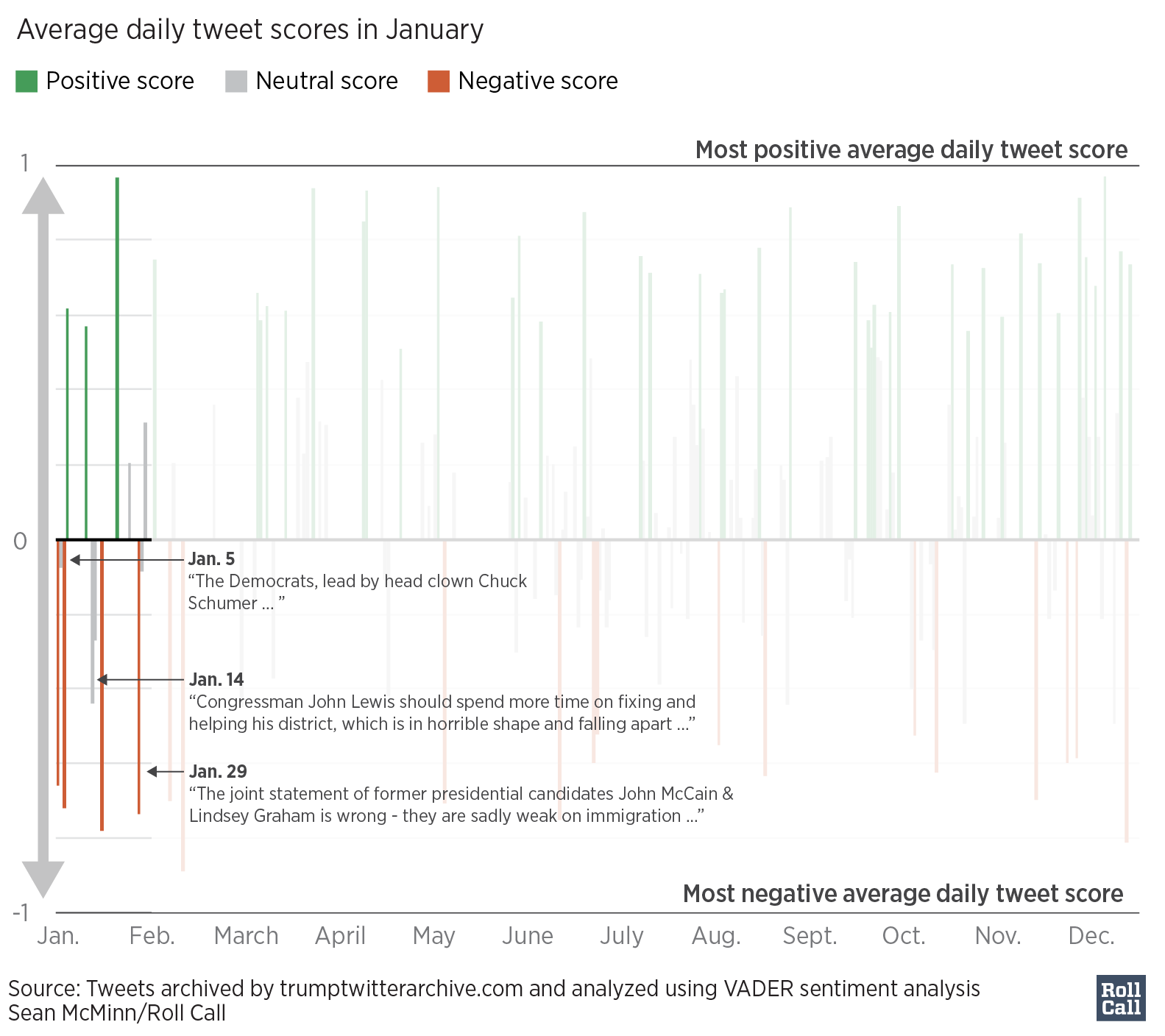Trump Used Twitter to Praise and Blame Congress, Yet the Hill Agreed With Him Most of the Time
Roll Call measured the sentiment of Trump's tweets, and Congress' presidential support score

President Donald Trump came into office with two chambers of Congress controlled by his own party. So it’s not surprising he got his way on almost all the votes he took a position on — a fairly typical barometer of a president’s legislative success.
But there’s another metric we can use almost exclusively for this president to measure his relationship with Congress: his Twitter account.
Trump has had his ups and downs with Congress during his first year in office, and he documented much of it on his favorite social media website.
We narrowed down the president’s tweets in 2017 (as of Friday, Dec. 15) to just those about Congress, looking for certain keywords that would indicate he was talking about the legislative branch (words like “Congress,” “Senate” and “filibuster,” plus every member’s name and Twitter handle). After that, we put each tweet through software called VADER, which is designed to capture the sentiment of social media posts. It spit out a weighted score for Trump’s tone and language in each tweet on a scale from -1 to 1, or most negative to most positive.
The results showed a president who is comfortable both complaining about and praising Congress, sometimes on the same day. Overall, the president had more tweets mentioning Congress in a positive way than a negative one — though the positive tweets weren’t any more or less likely to earn a large number of retweets.
The frequency of Trump’s tweets mentioning Congress seemed to mirror when the body was most active on high-profile issues. His first flurry of tweets about Congress came in March, the week after House leaders pulled a health care vote from the floor at the last minute and undermined the president’s promise to repeal the 2010 health care law.
 And his congressional tweets spiked in June and July, when Trump had plenty to comment on. He spent time retweeting praise of his decision to leave the international Paris climate agreement (@Jim_Jordan: “President Trump did the right thing by withdrawing us from Paris treaty”), weighing in on the Georgia special election to replace former Rep. Tom Price (“Karen Handel’s opponent in #GA06 can’t even vote in the district he wants to represent”) and blasting Congress as they left for August recess after again failing to pass an Obamacare repeal bill (“They look like fools and are just wasting time”).
And his congressional tweets spiked in June and July, when Trump had plenty to comment on. He spent time retweeting praise of his decision to leave the international Paris climate agreement (@Jim_Jordan: “President Trump did the right thing by withdrawing us from Paris treaty”), weighing in on the Georgia special election to replace former Rep. Tom Price (“Karen Handel’s opponent in #GA06 can’t even vote in the district he wants to represent”) and blasting Congress as they left for August recess after again failing to pass an Obamacare repeal bill (“They look like fools and are just wasting time”).
Some of the president’s most negative tweets of the year came within just the past month, as he weighed in on the special election for Alabama’s Senate seat.

In late November, he called Democratic candidate Doug Jones, who went on to win the race, a “Schumer/Pelosi puppet who is WEAK on Crime, WEAK on the Border, Bad for our Military and our great Vets, Bad for our 2nd Amendment, AND WANTS TO RAISES TAXES TO THE SKY.” That tweet scored a -0.96 on the VADER scale. In early December, he tweeted “Democrats refusal to give even one vote for massive Tax Cuts is why we need Republican Roy Moore to win in Alabama,” earning a -0.84 score.
Trump’s most negative month, on average, was January. Before he was sworn in, he hit Congress for its attempt to weaken the Office of Congressional Ethics, coined the term “head clown” for Democratic leader Sen. Charles E. Schumer and disparaged Atlanta Democratic Rep. John Lewis, saying he “should spend more time on fixing and helping his district, which is in horrible shape and falling apart.” During the second week of his presidency, Trump attacked two members of his own party, calling Sen. Lindsey Graham of South Carolina and John McCain of Arizona “sadly weak on immigration.”

September was the most positive month for Trump’s tweets about Congress. In several tweets that month, he praised Luther Strange as the appointed senator competed in the Republican primary ahead of Alabama’s special election.
Still, he (mostly) got his way on legislation
Despite the president’s mixed, and sometimes erratic, attitudes in his tweets about Congress, the more typical measurement of presidential support votes shows the legislative branch almost always sided with him.

According to CQ VoteWatch data, there were only two times in 2017 when Congress opposed the president after he clearly stated his position prior to a vote. Both of these votes came near the end of July, as the Senate twice rejected a bill that would repeal Obamacare.
Trump, however, took stances on fewer bills than his immediate predecessors did.
Excluding nominations, he’s made his position known on 39 votes, according to VoteWatch. Obama declared a position on 119 votes during his first year, and George W. Bush did the same for 77.
Democrats controlled both chambers of Congress during Obama’s first year in office, while the chambers were split during part of Bush’s first year.





